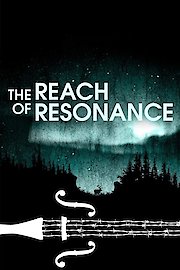-
Genres
-
CastJohn Luther AdamsKronos QuartetMiya Masaoka
-
DirectorSteve Elkins
-
MPAA RatingNR
-
Runtime1 hr 41 min
-
IMDB Rating8.4 (15)

The Reach of Resonance is a documentary film from 2012 that explores the relationship between sound and the natural world. Directed by Steve Elkins, the film features conversations with three contemporary composers - John Luther Adams, Miya Masaoka, and Pauline Oliveros - as well as performances by the Kronos Quartet. The film is structured as a series of vignettes, each of which focuses on a different aspect of the composers' work. The first segment features John Luther Adams discussing his interest in the sonic qualities of the Alaskan wilderness, where he has lived for many years. Adams describes how his compositions seek to capture the harmonies of the natural world, and how he uses his music to promote environmental activism.
The second segment of the film features percussionist and composer Miya Masaoka, who discusses her work with the koto - a traditional Japanese stringed instrument. Masaoka explains how she has sought to expand the possibilities of the koto by incorporating live electronics and digital processing. The film includes footage of Masaoka performing a piece called "Four Moons of Pluto" with the Kronos Quartet, which features complex interplay between the koto and the string quartet.
The third and final segment of The Reach of Resonance focuses on the work of composer and accordionist Pauline Oliveros. Oliveros is known for her contributions to the development of electronic music, and the film includes footage of her performing with a laptop computer to create immersive, multi-channel soundscapes. Oliveros also discusses her interest in using sound to create a sense of interconnectedness between individuals and communities.
Throughout the film, director Steve Elkins intercuts footage of the composers with stunning images of natural landscapes, from the frozen tundra of Alaska to the deserts of the American Southwest. The film's focus on the relationship between sound and nature is echoed in its stunning cinematography, which often lingers on detail shots of natural textures - rocks, plants, water - as well as aerial shots that capture the vast scale of the natural world.
One of the most striking elements of The Reach of Resonance is its use of sound design. The film's soundtrack is a mix of both natural and synthetic sounds, with recordings of wind, water, and wildlife alongside digital soundscapes and abstract electronic music. The result is a deeply immersive sonic experience that invites the viewer into the composers' worldviews.
Ultimately, The Reach of Resonance is a thought-provoking and visually stunning film that explores the power of sound to connect us to the natural world. Whether you are a seasoned listener of contemporary classical music or a curious newcomer, this film is sure to inspire a newfound appreciation for the beauty and complexity of sound.
The Reach Of Resonance is a documentary with a runtime of 1 hour and 41 minutes. It has received mostly positive reviews from critics and viewers, who have given it an IMDb score of 8.4.